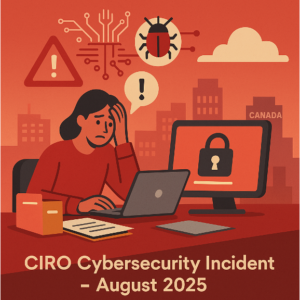As we know, on August 11, 2025, the Canadian Investment Regulatory Organization (CIRO) identified a Cybersecurity threat and as a precaution, CIRO proactively shut down some of its systems while ensuring critical operations remained functional.
https://www.ciro.ca/newsroom/publications/ciro–detects–cybersecurity–threat
It is indicated that some personal information belonging to member firms and their registered employees may have been affected. On its part, CIRO ensured the continuity of their real–time equity market surveillance operations. CIRO also maintained critical functionality throughout the incident. This means that even though business operations remained intact, the possible exposure of personal data remains a serious concern.
At this time, there is not enough information about the incident from CIRO on the nature of the threat or how the threat penetrated their IT systems thereby holding back the root–cause analysis. Possible guesses are the usual suspects: phishing, malware, vulnerability exploitation, or insider error.
CIRO is responding to the incident through ongoing investigation in collaboration with Cybersecurity and legal experts and law enforcement, and keeping its members informed through updates on their website. CIRO is also identifying the affected individuals to notify them directly and offering risk mitigation services while bringing non–critical systems back online and monitoring them for residual threats.
What does this mean from a Cybersecurity risk perspective?
- People: Possible lack of user awareness or training may have contributed in case employees fell for a phishing attack.
- Process: Possible absence of a practical and timely threat detection mechanism and / or absence of continuous monitoring or threat intelligence integration. Note: Presence of an Incident Response Plan (IRP) would help to certain extent in controlling the outage, after the incident has occurred. But this is not a substitute for proactive detection.
- Technology: Possible absence of advanced detection tools for intrusion detection, or Endpoint Detection & Response (EDR) / Extended Detection and Response (XDR) to identify and block threats before escalation.
While the actions taken by CIRO to identify the threats and shutting down systems to preserve critical functions is commendable, the incident reveals yet another situation that needs improvement. Preparedness, threat detection capability, awareness, data loss prevention / data protection are key areas that need additional efforts.
- Analysis:
This incident is yet another instance that undermines the efforts organizations take to contain and manage Cybersecurity incidents. The fact that a regulatory body mandated with overseeing investment compliance in Canada had to shut down its systems due to a cyber threat is a stark reminder that no institution is immune to cyber threats. This incident highlights a strong need to prioritize proactive and resilient Cybersecurity strategies and invest to implement and maintain adequate control over people, process and technology usage. It is a wake–up call not only for CIRO but for the larger financial ecosystem. Robust Cybersecurity management is no longer optional or reactionary.
- The way forward:
The need of the hour is to move beyond checkbox compliance and pursue continuous threat detection strategies, enhance staff awareness and revisit organizational risk management philosophies. An oft repeated statement: Cybersecurity must be embedded into the fabric of strategic and operational governance and control. Remember, cyber risk is business risk and it should be treated in a manner similar to other types of financial and operational risks. Cyber risk is not just technical failures, but it can lead to irreversible reputational and regulatory consequences and financial drain.
- Feel free to connect:
Let’s talk if you want your organization to adequately and appropriately manage Information / Cyber Security risk, be trusted by clients, become more prepared to handle Cybersecurity breaches and become resilient.
Authored by: Narasimham Nittala.




